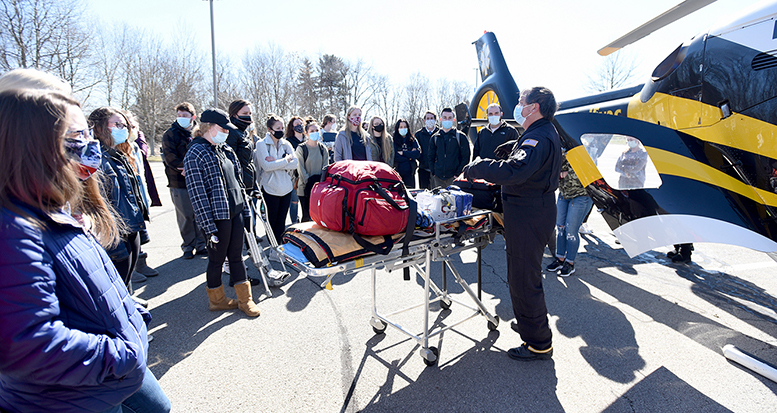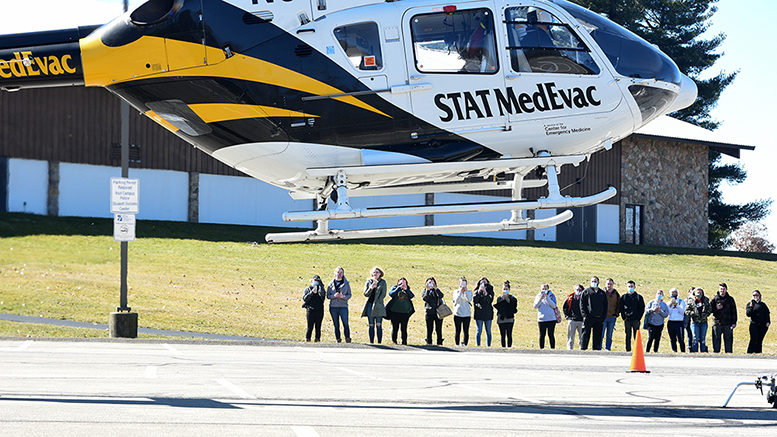Ian Miller looked inside the “emergency room and intensive care unit, with blades” – that’s how veteran flight nurse Ciara Rupp described the Airbus EC-135 STAT MedEvac helicopter to 42 Butler County Community College (BC3) registered nursing students an hour before – and saw where he might land in the future.
The 20-year-old has added flight nurse to career possibilities after Rupp introduced the future healthcare providers intending to graduate in May from the Pennsylvania college’s two-year career program to medical professions overhead.
As Rupp spoke about responding to dispatch tones signaling vehicular accidents, heart attacks or strokes, about grabbing her supplies and rushing to save lives at 140 mph and 1,000 feet in the air, an Airbus EC-135 STAT MedEvac helicopter approached in the eastern sky.
It circled BC3’s main campus, around the tract that in 2023 will become the college’s state-of-the-art Victor K. Phillips Nursing and Allied Health building, around the theater where Rupp stood on stage talking to registered nursing (RN) students, then landing in a parking lot.
After Rupp spoke, Miller and fellow RN students circled the helicopter.
“Doing critical-care nursing in this setting, that’s really unfathomable,” Miller said. “It’s just awesome. You are taking care of people in their absolute worst moments. In a helicopter. Those words together alone are just amazing.”
Outside the box
Bronder, a prehospital responder since 1999 and in her first semester of instructing a BC3 Nursing 104 course that requires clinical training in healthcare settings, arranged the presentation this month to familiarize her students with vast career opportunities, which include emergency care and disasters.
“I talk to the students one-on-one,” Bronder said. “I ask them what they want to do when they graduate. A couple of them think inside the box. A hospital. Nursing home. A doctor’s office.”
Bronder’s idea, Miller said, was outside the box.
“I’m not sure how she did it,” Miller said. “I’m not sure how BC3 did it. But I am very glad they were able to do it. It’s hard for me to imagine (other colleges or universities) are doing this right now. This is a very good education. I can tell you that much. It’s right there in front of you. How can you get better than that?”
Bronder, who holds a master of science degree in nursing, educates second-level nursing students and oversees their clinical training in hospitals. Nursing 104 is an eight-credit course in BC3’s 70-credit associate in applied science career program, in which students can develop the skills needed to enter the workforce immediately upon graduation.
Nursing 104 – nursing care of patients with complex health problems – prepares students to provide competent, holistic and evidence-based care for patients with multiple, or complicated medical-surgical disorders. BC3 registered nursing students travel to medical-surgical or critical-care hospital settings to attend clinical experiences.
Tight quarters for critical work
The flight crew on the helicopter included Rupp, two flight nurses, a pilot and a paramedic.
RN students also heard about Rupp’s semiweekly 24-hour shifts, where within five minutes of those tones signaling vehicular accidents, heart attacks or strokes, or patient transports needed from one facility to another, she said, “It’s skids up.”

Then they too looked inside the 6,400-pound helicopter.
“Not a lot of room in that office, is there?” Rupp asked 19-year-old student Bethany Harmon.
“No, you said it was tiny,” Harmon said. “But looking at it, I’m thinking, ‘No, no. This is much tinier.”
“It is,” Rupp said. “And when everything is loaded in there, and you are with the patient and your partner, it is.”
Everything loaded in there would also include oxygen systems. Suction units. Cooler for storing blood. Medications bag. A video laryngoscope. Multiple intravenous infusion pumps. A ventilator. Pediatric supplies. A cardiac monitor that can pace and defibrillate. An external pacemaker.
“Everything you would use in a normal hospital room is there, and ready to go,” said student Hunter Cihonski, 21. “In such a small, confined space. Everything that you would normally do, you do.”
Harmon said she has thought about becoming a flight medic, “and I’ve wanted to look into it as part of my nursing career. With everything we have done with BC3, it was incredible that they were able to give us this opportunity to look at this helicopter.”
Cihonski described the opportunity as “awesome. If I hadn’t been able to see it now,” he said, “I wouldn’t have been able to see it at all. It is very interesting to know there are other options.”


